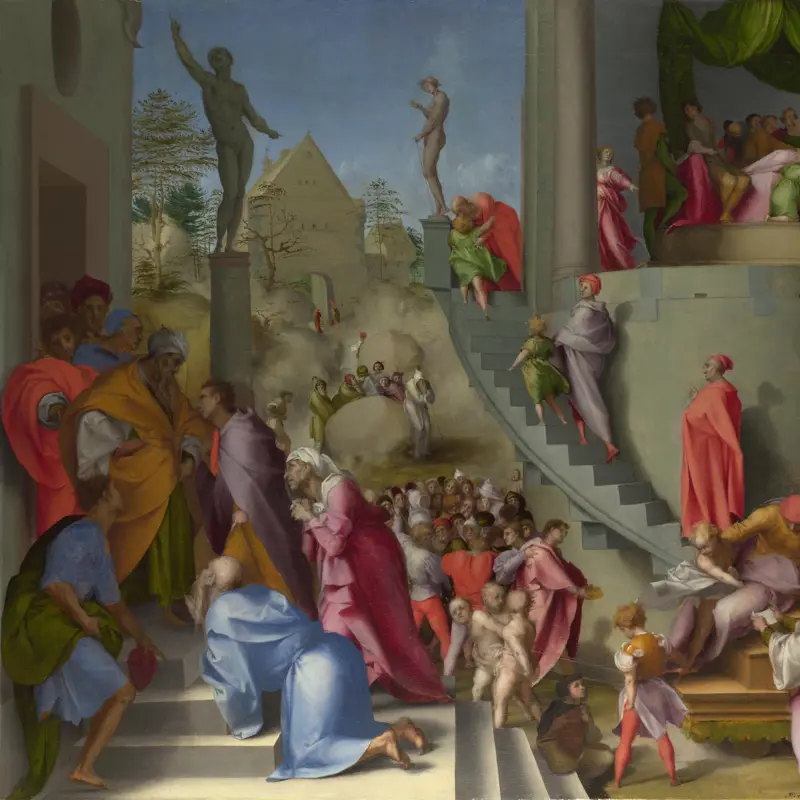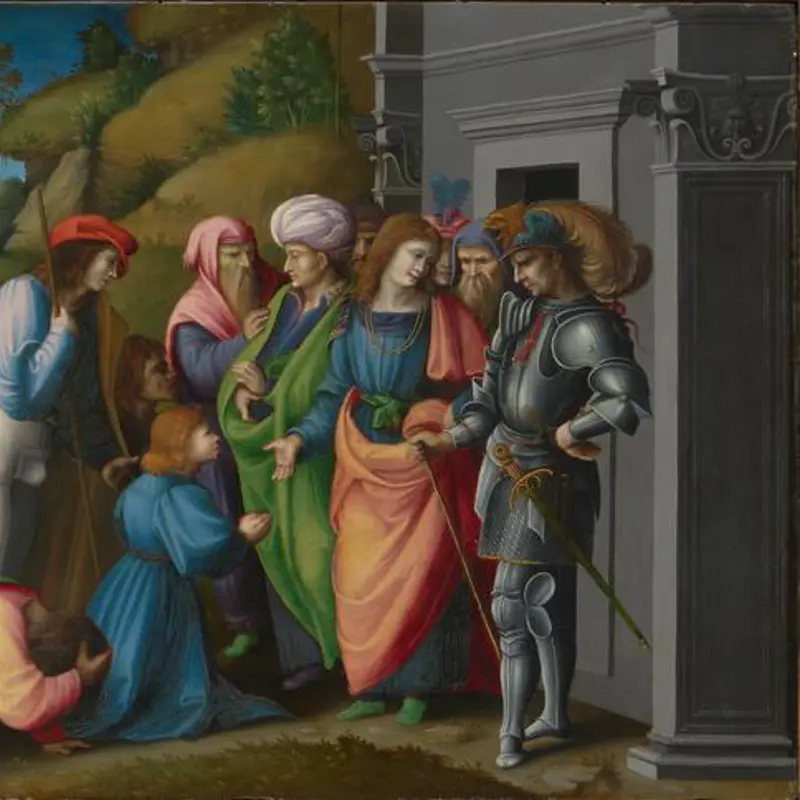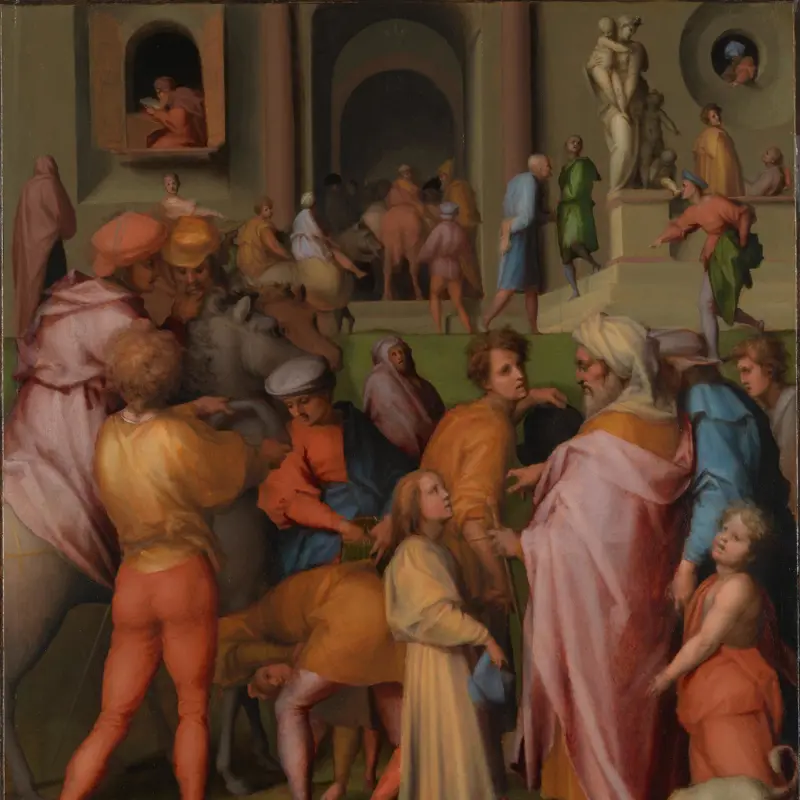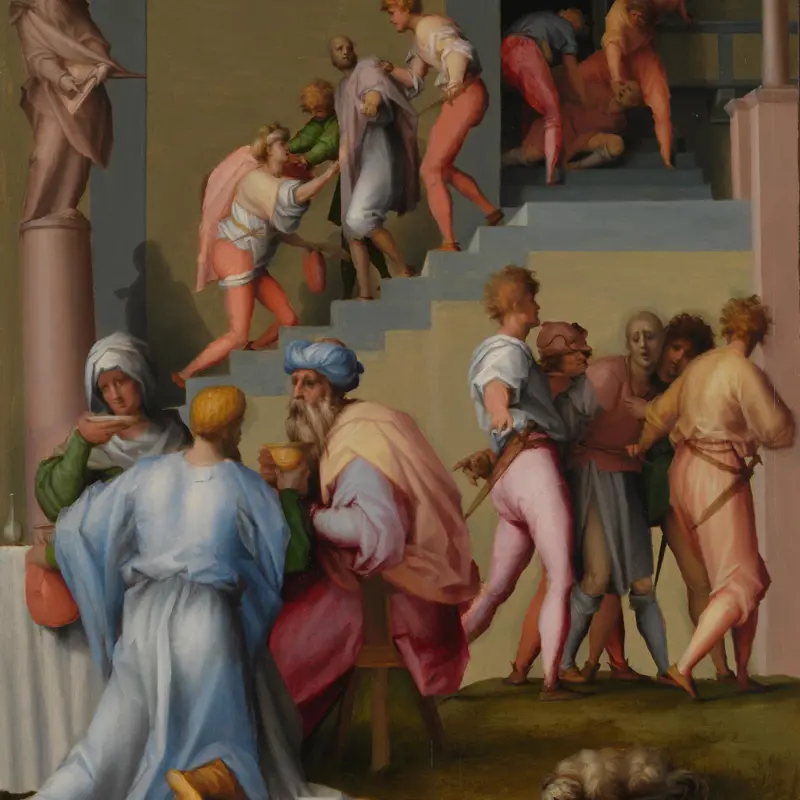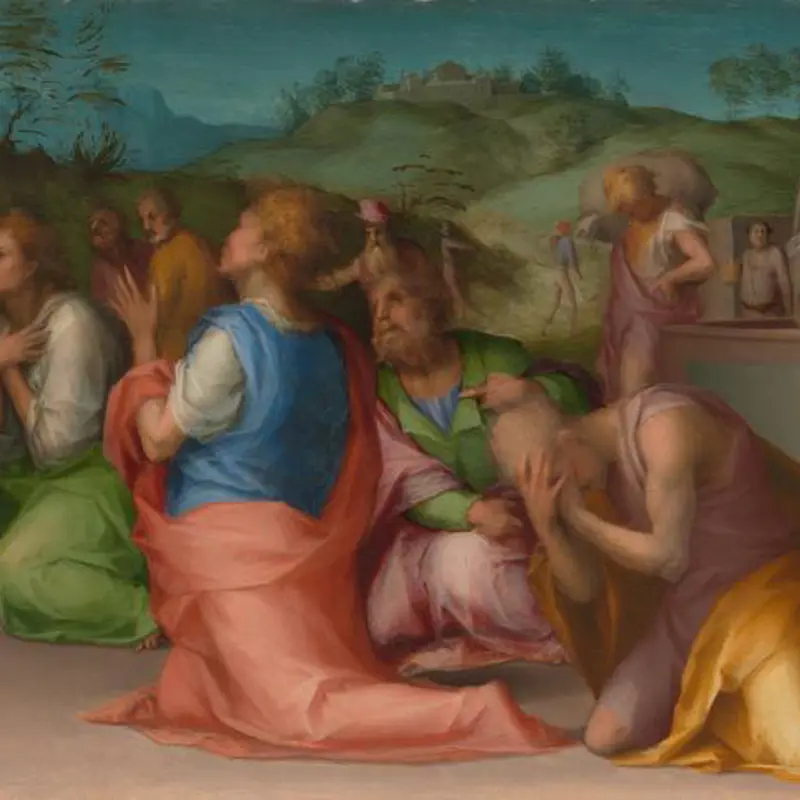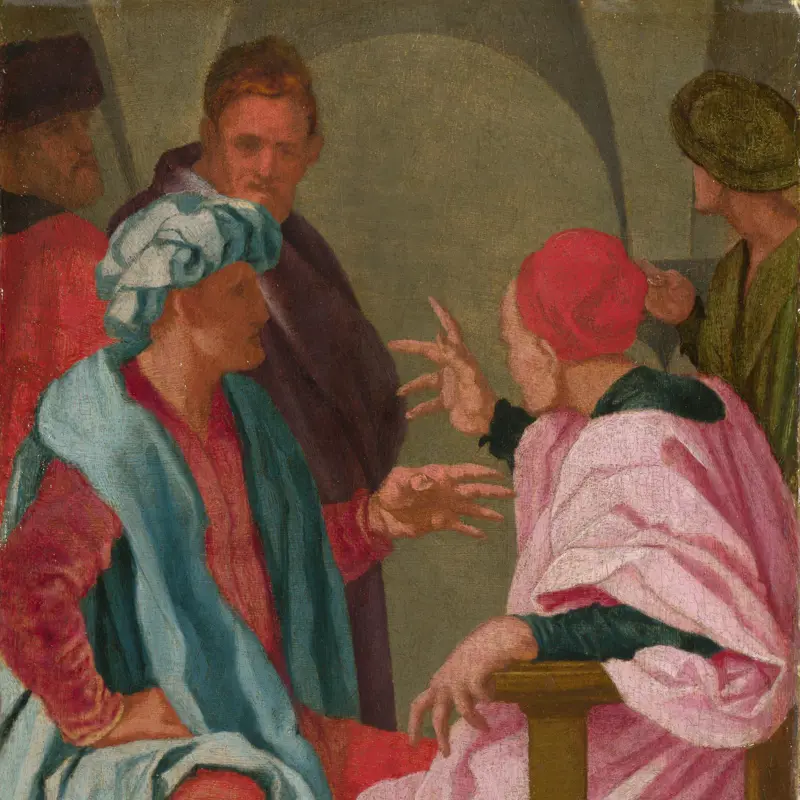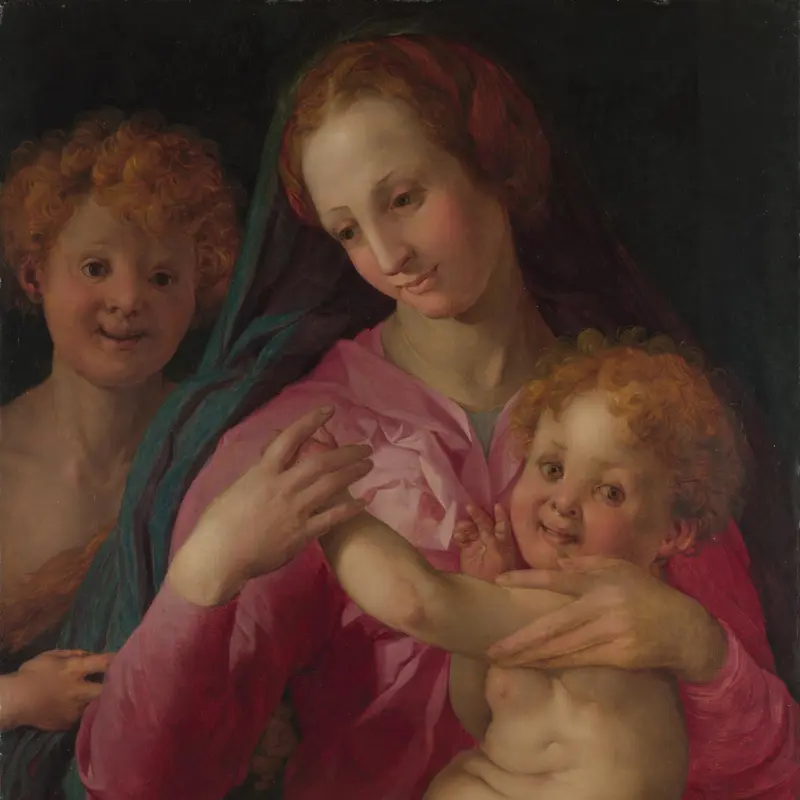Pontormo, 'Joseph sold to Potiphar', about 1515
About the work
Overview
This picture formed part of the decoration of the bedroom of Pierfrancesco Borgherini in the Borgherini palace in Florence, and was commissioned to celebrate his marriage in 1515. The story is taken from the Old Testament (Genesis 39: 1). Joseph had been his father’s favourite son and was given a coat of many colours by him. His jealous half-brothers sold Joseph to a caravan of Ishmaelite merchants taking perfumes and spices to Egypt. The brothers smeared goat’s blood on Joseph’s coat and told their father that Joseph was dead.
This scene shows Joseph (the central young boy in yellow) standing before his new master, Potiphar, the captain of Pharaoh’s guard, to whom he has just been sold. The Ishmaelites are grappling for their payment on the left. One of them bends over, his back to the viewer and his head between his legs, to pick up a coin from the ground.
Key facts
Details
- Full title
- Joseph sold to Potiphar
- Artist
- Pontormo
- Artist dates
- 1494 - 1556/7
- Part of the series
- Scenes from the Story of Joseph
- Date made
- About 1515
- Medium and support
- Oil on wood
- Dimensions
- 61 × 51.6 cm
- Acquisition credit
- Bought with the aid of the Art Fund (Eugene Cremetti Fund), 1979
- Inventory number
- NG6451
- Location
- Room 7
- Collection
- Main Collection
- Frame
- 20th-century Replica Frame
Provenance
Additional information
Text extracted from the National Gallery’s Annual Report, ‘The National Gallery Report: January 1978 – December 1979’.
Exhibition history
-
2014Pontormo & Rosso Fiorentino: Diverging paths of mannerismPalazzo Strozzi8 March 2014 - 20 July 2014
Bibliography
-
1584R. Borghini, Il riposo di Raffaello Borghini, Florence 1584
-
1835A. von Reumont, Andrea del Sarto, Leipzig 1835
-
1838G. Rosini, Introduzione alla storia della pittura italiana, 9 vols, Pisa 1838
-
1854G.F. Waagen, Treasures of Art in Great Britain: Being and Account of the Chief Collections of Paintings, Drawings, Sculptures, Illuminated Mss. […], vol. 2, trans. E. Eastlake, London 1854
-
1878G. Vasari, Le vite de'più eccellenti pittori, scultori ed architettori: Con nuove annotazioni e commenti di Gaetano Milanesi, ed. G. Milanesi, 8 vols, Florence 1878
-
1883J.P. Richter, Italian Art in the National Gallery, London 1883
-
1901A. Venturi, Storia dell'arte italiana, 11 vols, Milan 1901
-
1903J.A. Crowe and G.B. Cavalcaselle, A History of Painting in Italy, Umbria, Florence and Siena, from the Second to the Sixteenth Century, ed. R.L. Douglas, 2nd edn, 6 vols, London 1903
-
1911F. Goldschmidt, Pontormo, Rosso und Bronzino, Leipzig 1911
-
1916F.M. Clapp, Jacopo Carucci Da Pontormo: His Life and Work, New Haven 1916
-
1921C. Gamba, Il Pontormo, Florence 1921
-
1923P. Schubring, Cassoni: Truhen und Truhenbilder der italienischen Fruhrenaissance: Ein Beitrag zur Profanmalerei im Quattrocento, Leipzig 1923
-
1926A. McComb, 'Bacchiacca', Art Bulletin, VIII, 1926
-
1933I. Fraenckel, 'Jugendwerke Pontormos', in Festschrift für Walter Friedländer, Florence 1933, pp. 146-79
-
1935I. Fraenckel, Andrea del Sarto: Gemälde und Zeichnungen, Strasbourg 1935
-
1943E. Toesca, Il Pontormo, Rome 1943
-
1943W. Stechow, 'Jacob Blessing the Sons of Joseph', Gazette des beaux-arts, VII/32, 1943
-
1944L. Becherucci, Manieristi toscani, Bergamo 1944
-
1947G. Nicco Fasola, Pontormo o del Cinquecento, Florence 1947
-
1953R. Wischnitzer, 'Jacopo Pontormo's Joseph Scenes', Gazette des beaux-arts, 1953, pp. 145-66
-
1956C. Gamba, Contributo alla conoscenza del Pontormo, Florence 1956
-
1956D. Sutton, 'Paintings at Firle Place', The Connoisseur, 1956, pp. 78-84
-
1956L. Berti et al., Mostra del Pontormo e del primo manierismo fiorentino (exh. cat. Palazzo Strozzi, 24 March -15 July 1956), Florence 1956
-
1956G.N. Fasola, Alcune Revisioni sul Pontormo, Quaderni Pontormeschi 4, Florence 1956
-
1958S. McKillop, The Decorative Scheme for the Borgherini Bridal Chamber, Unpublished Paper, Cambridge MA 1958
-
1958L. Marucci, 'Contributo al Baccaccia', Bollettino d'arte, 1958
-
1959P. Della Pergola, Galleria Borghese: I dipinti, Rome 1959
-
1961S.J. Freedberg, Painting of the High Renaissance in Rome and Florence, Cambridge MA 1961
-
1963S.J. Freedberg, Andrea del Sarto: Catalogue Raisonné, Cambridge MA 1963
-
1964L. Berti, Pontormo, Florence 1964
-
1965R. Monti, Andrea del Sarto, Milan 1965
-
1965J. Shearman, Andrea del Sarto, Oxford 1965
-
1965F. Abbate, 'L'attività giovanile del Bacchiacca', Paragone, XVI/189, 1965, pp. 26-49
-
1965I. Zupnick, 'Pontormo's Early Style', Art Bulletin, 1965, pp. 348-9
-
1966K.W. Forster, Pontormo: Monographie mit kritischen Katalog, Munich 1966
-
1966L. Nikolenko, Francesco Ubertini Called Il Bacchiacca, Munich 1966
-
1967E. Maurer, 'Pontormo und Michelangelo', in Stil und Überlieferung in der Kunst des Abendlandes: Akten des 21. Internationalen Kongresses für Kunstgeschichte in Bonn 1964, Berlin 1967
-
1970J. Cox-Rearick, 'The Drawings of Pontormo: Addenda', Master Drawings, II, 1970, pp. 363-78
-
1974C. von Holst, Francesco Granacci, Munich 1974
-
1974S.R. McKillop, Franciabigio, Berkeley 1974
-
1975C. Gould, Delaroche and Gautier: Gautier's Views on the 'Execution of Lady Jane Grey' and on other Compositions by Delaroche, London 1975
-
1978A. Pinelli, Museo perché, museo come (exh. cat. Civici Musei di Storia ed Arte, 1978; Palazzo delle Esposizioni, 23 October - 31 October 1978), Treviso 1978
-
1979A. Braham, 'The Bed of Pierfrancesco Borgherini', The Burlington Magazine, CXXI/921, 1979, pp. 754-65
-
1980National Gallery, The National Gallery Report: January 1978 - December 1979, London 1980
-
1980J. Mills and R. White, 'Analyses of Paint Media', National Gallery Technical Bulletin, IV, 1980, pp. 65-7
-
1981J. Cox-Rearick, The Drawings of Pontormo: A Catalogue Raisonné with Notes on the Paintings, 2nd edn, New York 1981
-
1982D. Sutton, 'Aspects of British Collecting, II.VIII: From Rome to Naples', Apollo, CXVI/250, 1982, pp. 358-420
-
1982G. Smith, 'Cosimo I and the Joseph Tapestries for the Palazzo Vecchio', Renaissance and Reformation, VI/3, 1982, pp. 183-96
-
1986A. Cecchi and M. Chiarini, Andrea del Sarto, 1486-1530: Dipinti e Disegni a Firenze, (exh. cat. Palazzo Pitti, 8 November 1986 - 1 March 1987), Florence 1986
-
1986D. Cordelier, Hommage à Andrea del Sarto (exh. cat. Musée du Louvre, 23 October 1986 - 26 January 1987), Paris 1986
-
1987Gould, Cecil, National Gallery Catalogues: The Sixteenth Century Italian Schools, London 1987
-
1987M.G. de La Coste-Messelière, 'Pour la république florentine et pour le roi de France: Giovanbattista della Palla, des "orti oricellari" aux cachots de Pise', in Il se rendit en Italie, études offertes à André Chastel, Paris 1987, pp. 195-208
-
1989A. Cecchi and A. Natali, Andrea del Sarto: Catalogo completo dei dipinti, Florence 1989
-
1991S.S. Nigro (ed.), Pontormo: Zeichnungen, Munich 1991
-
1992J.-C. Lebensztejn, Le journal de Jacopo da Pontormo, Paris 1992
-
1992N. Pons, 'La "camera Borgherini" e l'arredo del palazzo Rosselli Del Turco', in G. Trotta (ed.), Gli Antichi Chiassi Tra Ponte Vecchio E Santa Trinita, Florence 1992, pp. 179-83
-
1993L. Berti, Pontormo e il suo tempo, Florence 1993
-
1993S.S. Nigro, Pontormo. Fresken und Gemälde, Munich 1993
-
1994A.B. Barriault, Spalliera Paintings of Renaissance Tuscany: Fables of Poets for Patrician Homes, Univerisity Park PA 1994
-
1994P. Costamagna, Pontormo, Milan 1994
-
1994A.F. Tempesti, Pontormo, Florence 1994
-
1994R.C. Proto Pisani, 'Le Opere: I Santi di Pontormo', in Il Pontormo a Empoli, Florence 1994
-
1995Palais des beaux-arts, Lille, Lille, chefs-d'oeuvre d'ue grand musée européen (exh. cat. Galeries Nationales du Grand Palais, 31 March - 3 July 1995), Paris 1995
-
1997C. Fulton, 'Present at the Inception: Donatello and the Origins of Sixteenth-Century Mannerism', Zeitschrift für Kunstgeschichte, II, 1997, pp. 166-99
-
1997A. Cecchi et al., L'officina della maniera: Varietà e ferezza nell'arte fiorentina del Cinquecento fra le due repubbliche 1494-1530 (exh. cat. Uffizi, 28 September 1996 - 6 January 1997), Florence 1997
-
2001
C. Baker and T. Henry, The National Gallery: Complete Illustrated Catalogue, London 2001
-
2001V. Ficklin, 'Mannerist Staircases: A Twist in the Tale', Athanor, XIX, 2001, pp. 27-33
-
2002C. Plazzotta and R. Billinge, 'The Underdrawing of Pontormo's "Joseph with Jacob in Egypt"', The Burlington Magazine, CXLIV/1196, 2002, pp. 660-70
-
2002D. Bomford et al., Underdrawings in Renaissance Paintings (exh. cat. The National Gallery, 30 October 2002 - 16 February 2003), London 2002
About this record
If you know more about this work or have spotted an error, please contact us. Please note that exhibition histories are listed from 2009 onwards. Bibliographies may not be complete; more comprehensive information is available in the National Gallery Library.
Images
About the series: Scenes from the Story of Joseph
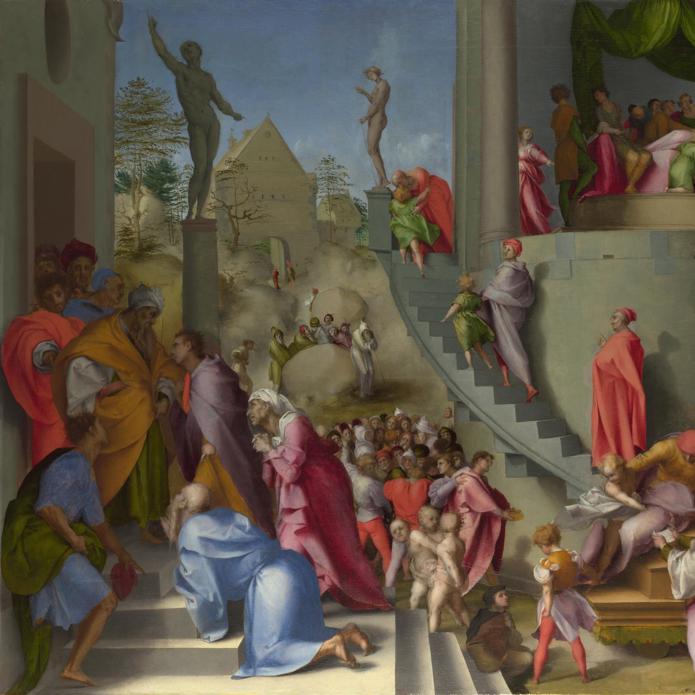
Overview
These six pictures by Pontormo and Bacchiacca were part of a larger series of panel paintings commissioned to celebrate the marriage of Pierfrancesco Borgherini to Margherita Accaiuoli in 1515. The series decorated the couple’s bedroom in the Borgherini palace in Florence. Francesco Granacci and Andrea del Sarto also contributed to the decorative scheme, which would have been one of the most sumptuous of the time. The paintings, telling the story of Joseph from the Old Testament (Genesis 39), would have been set into the wall panelling and furniture.
Pontormo’s interest in the emerging new style known as Mannerism – a reaction against the harmony, proportion and naturalism of High Renaissance art – is evident in his bright colours, disconcertingly unnatural approach to space, elongated figures and spiralling compositions. Bacchiacca’s scenes are expressive and dramatic but stylistically more conventional.

